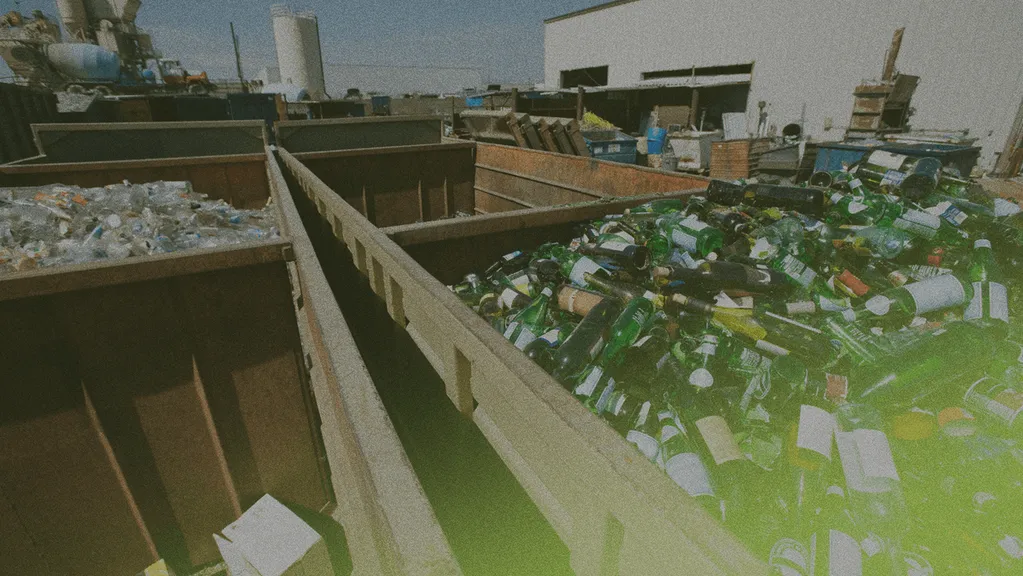Glass containers used for beverages are some of the most common items collected by curbside glass recycling programs, alongside plastic bottles and aluminum cans. You’ve probably heard that glass is 100% recyclable and can be recycled endlessly. However, glass recycling is one of the most complicated processes due to the material’s weight, low commodity value, and tendency to break. Not all glass is made the same, and only certain types can be recycled depending on where you live.
Compared to new glass containers, recycled glass reduces air pollution by 20% and water pollution by 50%. Recycling glass containers also helps reduce the need for raw materials, waste in landfills, and disposal costs.
How Glass Is Recycled
If you're wondering how glass is recycled, the process includes collecting, sorting by color, cleaning, crushing into cullet, and remelting it into new containers. Unfortunately, the recycling rate for glass in the United States is only 34%. In comparison, the recycling rate for aluminum cans is 67%.
What to Do With Broken Glass
Broken glass is not only dangerous, but it also has little to no recycling value. Wrap small amounts in paper or a plastic bag before placing them in the trash to protect sanitation workers. For larger items like broken windows or mirrors, schedule a bulk pickup.
If your glass waste comes from a construction project, Sourgum offers construction dumpsters for rent. We provide consistent and reliable service with a variety of dumpster types and sizes to suit your project needs, and our customer support is available seven days a week.
What to Do with Large Quantities of Glass
If you have a large quantity of unwanted glass, whether broken or unbroken, Sourgum can help. For broken glass, we can deliver a roll-off dumpster and ensure proper disposal. If you have unbroken glass, contact us and we’ll help coordinate the most environmentally responsible solution.
Glass Products that Can't Be Recycled
When we think of recycling glass, we usually imagine bottles and jars tossed into the bin and turned into new containers. But not all glass items follow the same rules. The reality is that many everyday glass products are made with different materials and melting points that make them incompatible with standard recycling processes.
These differences are more than just technical. Mixing the wrong type of glass into a recycling batch can ruin an entire load, forcing facilities to send it all to a landfill. That’s why it’s important to know which glass items are accepted in your local glass recycling program, and which ones aren’t.
Here are some common glass products that typically cannot be recycled curbside, along with tips on how to handle them responsibly.
Kitchen Glassware
People often wonder if glass cups recyclable, and in most cases, the answer is no. Manufacturers add materials to make them more durable, which raises their melting point compared to bottles or jars.
If mixed with recyclable glass, they can contaminate the entire batch. Unfortunately, there are no recycling programs for these items. Unfortunately, there are no recycling programs for these items. Their long lifespan and relatively low volume make separating them cost-prohibitive for recycling facilities.
Lightbulbs
According to the Environmental Protection Agency (EPA), CFLs, fluorescent bulbs, and other types of bulbs contain mercury, which is a hazardous material. Mercury can be released into the environment if a bulb breaks in a landfill. Almost every part of a lightbulb is recyclable, from the glass to the metal and other components, but they cannot be placed in curbside bins.
It’s recommended to check with your local recycling programs to see what options exist for lightbulbs. Some communities host recycling events once per year, while others have ongoing drop-off options. Home Depot, Ikea, and Lowe’s also offer recycling programs for lightbulbs and other hazardous waste.
LEDs and incandescent bulbs do not contain mercury but may still not be recycled due to collection and processing costs.
Windows
Windows are made of treated glass. This type of glass is manufactured with chemicals to make it stronger and harder to break than container glass. It also has a higher melting point. While it's possible to recycle treated glass if the entire batch is uniform, most recycling facilities do not have the proper equipment for this.
Mirrors
Mirrors are difficult to recycle because of the reflective coating on the back of the glass. They also have a different melting point compared to glass bottles and containers. Instead of throwing them away, consider donating mirrors to antique shops, vendors, or secondhand stores.
Broken mirrors can be reused for creative crafts such as mosaics or wind chimes. If the broken pieces are large enough, a mirror can be cut and reframed into a smaller one. If repurposing isn’t an option, some nonprofit organizations that sell craft supplies may accept them.
Recycle Nation provides a good analogy to explain why treated glass cannot be recycled with regular glass containers: Imagine trying to melt crayons and Styrofoam together. The crayon melts first, but the Styrofoam stays solid. The result is ruined because the melted crayon ends up filled with unwanted lumps.
Eyeglasses
More eyeglasses exist in the U.S. than people when you include sunglasses, prescription glasses, and over-the-counter readers. Despite how many are in circulation, most pairs are replaced every two years, often while still in good condition. If your prescription hasn’t changed, it’s a good idea to keep your old glasses as a backup.
When you no longer need them, donating eyeglasses is the most impactful option. The Lions Club and other organizations collect gently used glasses and distribute them to people in need across the world. Many eyewear retailers also participate in donation programs, making it easy to give your old pair a second life.
How to Recycle Glass Curbside
Check whether your community offers curbside glass recycling. Some cities only accept glass at drop-off locations.
Follow local guidelines to avoid contaminating the recycling stream.
Remove caps from glass bottles. These are recycled with metals.
Take wine corks to designated cork recycling drop-offs.
Rinse bottles and jars to keep pests away.
Solid items left inside bottles, such as lime wedges, do not need to be removed, as they will burn off during processing. However, only clean, intact bottles and jars are considered glass that can be recycled in most curbside programs.
Prevent glass bottles and jars from breaking in your bin so they remain recyclable.
Check out our in-depth glass recycling cheat sheet for more information.


